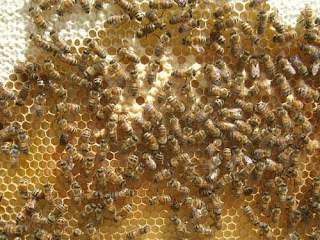Sometimes the
paparazzi can't find you so there's no photos. That's what happened in this event. Well, sort of.
I got home from work and was supposed to have a couple hours free before leaving for a meeting. Then the phone rang and I answered. There was a small swarm a couple streets over in a neighbour's backyard bush. The
neighbour explained that they'd even built a little honeycomb. This was a good sign that they really were bees and not wasps or hornets. Would I be interested in collecting it?
Sure I thought, why not since I happen to have an empty hive. I called Dad. My first words were "Get your camera", my second were "Meet me at..."
So there was a camera on hand the whole time we collected the swarm.
The swarm collection went like the textbooks describe: Simple and straightforward.
I was amazed to see three small pancake size combs attached to a thick bush. We'd had rain the night before with more storms predicted so it wasn't the wisest place for bees to make a nest. There was capped brood so this indicated that they must have a queen and also that they'd probably been there for at least 15 days--3 days as an egg, 8 days as a larva, and approximately 3 days to build the comb.
Luckily the bush wasn't too tall and a small stepladder was sufficient to reach them. But it is hard to crawl into a bush and
maneuver around without dropping combs. Dad held a frame under me like a plate as I worked to catch he bees and comb.
We cut the branches and comb and laid them in the hive and then put the lid on. Many bees began to collect on the outside of the box and move inside.
It was fascinating to watch the air filled with bees flying into the bush. Then in confusion for a half hour or so flying in the air trying to find their home. You could literally watch the bees flying lower and lower in circles while they located their home.
By 6:00 p.m. they were mostly clustered outside the box. By 9:00 p.m. they were all inside. We taped the entrance closed, loaded the box in the truck and I drove 2 streets to my home.
I wondered if the bees would orient back to their old location so I deliberately tried to cause a "forced re-orientation". This is shown very nicely in
Mistress Beek's Blog - The Lazy Way to Move a Hive.
You need to totally change the exit so that in the morning as the bees go to leave the hive they will notice things are different. Then they'll do reorientation flights in front of the hive before they leave to forage. That way when they return they'll come back to their new location and not the old.
Small swarms are predicted to be a waste of time. Time will tell, or so I thought. The bees were there in the morning when I gave them a hive feeder. They were still there after 9:00 a.m., when dad dropped by the check on them.
But when I got home at 5:00 p.m. they'd left. Maybe they saved me the effort of trying to nurse a tiny swarm through winter. The experience though was something I wouldn't miss for anything.
And sorry about no photos. Let's blame dad. He brought the camera and didn't use it.
Update:This is a list of
beekeepers in southwestern Ontario who will collect swarms.
If you have bees in an attic, garage, etc., or have a swarm you can find beekeepers who will collect them by checking with the bee clubs/associations for that province or state. I have a few of them listed on my web site
Associations page.
Sometimes people will sign up to the beekeeping Yahoo group and post a message for help as well. They're also listed on the Associations web page.
 I'm so proud of our bees.
I'm so proud of our bees.









 Time for the second week inspection of our new hives.
Time for the second week inspection of our new hives.











